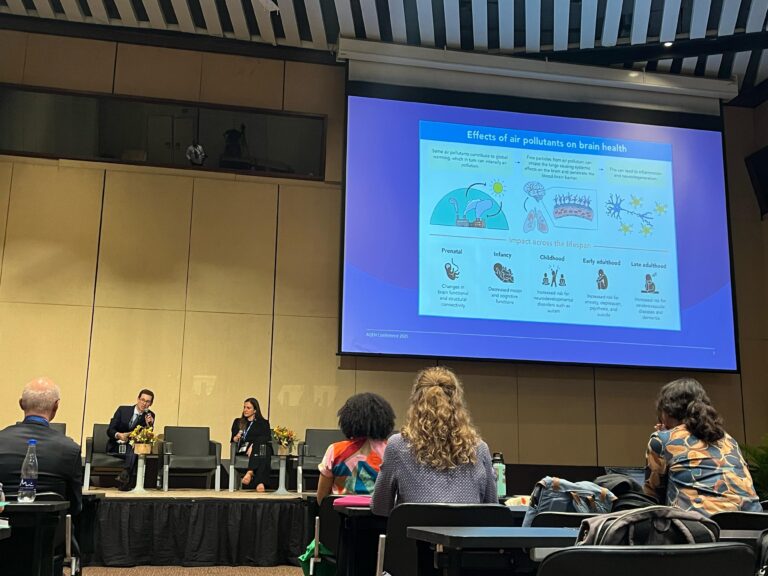Progressing action on air pollution to safeguard mental health and the planet: A recap of the WHO 2nd Conference on Air Pollution and Health
By Alessandro Massazza, Policy and Advocacy Advisor, Environment and Climate Change

A mural designed by Brazilian artist Eduardo Kobra on the occasion of the WHO Second Conference on Air Pollution and Health in Cartagena, Colombia. Credit: World Health Organization
The conference in brief
Over 700 policymakers, researchers, and advocates from 100 countries met in Cartagena, Colombia the week of the 24th of March 2025 to discuss how to progress action on air pollution in order to protect our health and the planet.
In the lead-up to the conference, nearly 50 million people signed a call for clean action for better health.
The World Health Organization set a quantifiable global target and roadmap of halving mortality from air pollution by 2040 (relative to 2015 baseline values) to save millions of lives every year.
Over 50 countries, cities, and organisations pledged to align with this goal. Among these, 17 governments announced national commitments to address air pollution and protect health. These included:
- The UK, Brazil, Mexico, China, and Vietnam committed to updating their national air quality standards in order to align them more closely with the WHO Global Air Quality Guidelines.
- Various countries including Germany, Mexico, and Mongolia committed to updating their sectoral policies to improve air quality. For example, Mexico pledged to include black carbon (commonly known as soot) in its national vehicle regulations to reduce the emission of particulate matter.
- Spain, Norway, Somalia and Cuba made commitments to transitioning to cleaner energy in key sectors such as agriculture and health. For example, Somalia committed to transitioning 75% of its households to clean cooking.
- New funding commitments were made. The UK government committed to new funding in the context of its ongoing support to the Climate and Clean Air Coalition (co-chaired by the UK and Brazil) by providing £700k to clean air work in Africa via the Africa Clean Air Programme. Norway also committed to supporting international development work on clean air. Finally, the Clean Air Fund pledged a further £90 million for climate and health efforts in the next two years, in addition to the £110 million already spent.
- Various governments including the Philippines, Pakistan, and France highlighted the economic burden resulting from the health impacts of air pollution.
- Better data on air pollution and health was identified as an area of improvement by Spain, Vietnam, Mongolia, Mexico, and the Gambia and commitments to improve health assessments and surveillance systems for air pollution were made by Brazil, France, India, the Philippines, and Vietnam.
You can read more about the commitments made here and here.
How did mental health feature in the conference?
We are seeing growing evidence of the impacts that air pollution is having on brain health and mental health.
A key message that came across the conference was that air pollution is impacting every organ of our bodies, from our hearts and lungs to our brains, therefore also impacting our mental health.

Dr. Maria Neira, Director of the Department of Environment, Climate Change, and Health at the World Health Organization talking through how air pollution impacts organ systems across the body.
A session was held focusing on the impact of air pollution on noncommunicable diseases (NCDs) and that included a section covering mental health and brain health by myself and Dr. Burcin Ikiz, the chair from the International Neuro Climate Working Group at Columbia University. I highlighted the growing evidence on how air pollution is contributing to increased symptoms of certain mental health problems such as depressive symptoms and suicide. Exposure to air pollution during early life has also been shown to increase the risk for mental health problems such as depression and psychosis in adolescents and young adults. Additionally, air pollution may contribute to worsening mental health in people with pre–existing mental health conditions. Importantly, people living with chronic and severe mental health problems often live with comorbid non-communicable diseases such as cardiovascular and respiratory conditions which make them even more vulnerable to the physical health impacts of air pollution.
We still don’t fully understand what may be behind these associations. As with most things in mental health, it is likely the result of a complex interaction of biological (e.g., the impact of air pollution on brain inflammation and oxidative stress), psychological (e.g., the impact of air pollution on cognition, mood, and sleep), and social factors (e.g., people being stuck at home due to acute air pollution episodes and not being able to go outside to exercise and socialise) .
Importantly, actions aimed at reducing air pollution can hold substantial co-benefits for mental health, whether it’s increased access to green and blue spaces, reduced energy poverty, or more physical activity in the context of active modes of transport such as walking and cycling. In China, clean air policies have been identified as having prevented 46,000 suicides in the country over just 5 years.
You can read more about the session in this article by Health Policy Watch here.

Dr. Alessandro Massazza (left) and Dr. Burcin Ikiz (right) presenting on mental health and brain health in the context of air pollution at the session on air pollution and noncommunicable diseases.
Where next?
Overall, going forward, these are some points of reflection for the mental health community on the links between air pollution and mental health.
- There was a strong perception from the overall air pollution and health field that more research is needed on mental health and air pollution. We therefore need to become more strategic about how to effectively communicate the research that already exists in this space but also think about how to robustly establish quantifiable impacts of air pollution on mental health outcomes such as depression and anxiety. One avenue may be that of expanding the research that has been used to quantify the impacts of air pollution on non-communicable diseases and other health outcomes using the Global Burden of Disease data (see the State of Global Air Report 2024) by linking the GBD data on mental health and brain health outcomes to air pollution data.
- Overall, people seem to struggle with understanding how air pollution impacts mental health. While it is subjectively easier to imagine how air pollution impacts our lungs through the air we breathe, thinking about how air pollution impacts our mental health can be more challenging. Therefore, we may want to consider how to tell this story effectively, e.g., by using concrete case studies such as those of people being forced to remain isolated at home due to acute levels of air pollution and not being able to have access to their usual coping mechanisms such as outdoor physical activity or socializing, resulting in worsened mental health.
- It was often easier for people to understand how clean air policies may hold co-benefits for mental health (e.g., by increasing access to green spaces or physical activity), pointing to a possible role of mental health in supporting the call for ambitious clean air action.
- A mental health framing may also be helpful in showing the human face of the impacts of air pollution on health. Jaw-dropping statistics were presented at the conference: from the more than 7 million premature deaths happening every year because of air pollution to air pollution now being the number one risk factor for disability-adjusted life years. Behind every one of these deaths and years lived with a disability, there are real people experiencing these impacts. A powerful testimony from Rosamund Adoo-Kissi-Debrah, the mother of Ella, a nine years old girl that was the first person to have air pollution listed as a cause of death on her death certificate, highlighted the profound psychological impacts that morbidity and mortality from air pollution can have on affected people and families. Rosamund described how: “For Ella, one of the biggest ways of advocating for her was to get her mental health support as if you imagine a child who is always coughing and think they are going to die, from me looking back, was how petrified she actually was”.

Rosamund Adoo-Kissi-Debrah talking about the death of her daughter, Ella, due to air pollution, and about the mental health consequences it had on Ella and herself
- We often think about alcohol, tobacco, and unhealthy foods as commercial determinants of health but fossil fuels are being increasingly added to the list, for example by the World Health Organization. The burning of fossil fuels is the main driver behind morbidity and mortality due to air pollution as well as anthropogenic climate change and is being increasingly recognized as a commercial determinant of health, including for mental health. A full phase-out of fossil fuels would lead to huge co-benefits for physical and mental health both through the reduction of air pollution as well as through the mitigation of climate change.
- Air pollution is a truly cross-sectoral issue. From the exhaust of the cars we use to the fertilizers used to grow the food we eat, air pollution is dependent on a wide array of sectors. Whether it’s transport, energy, or waste, these are often sectors that we have not traditionally engaged with as a mental health community. In line with a Health in All Policies framework, we should start thinking more about how to interact with these mental health-determining sectors. This is particularly relevant as countries this year develop their third round of Nationally Determined Contributions, the pledges countries submit to show how they are aligning with the Paris Agreement, which often focus on key sectors responsible for air pollution.
- We need to continue collaborating closely with the non-communicable diseases community, especially in the lead-up to the UN High Level Meeting on NCDs and Mental Health. Virtually every death due to air pollution (around 90%) is from NCDs such as heart disease, stroke, lung cancer, and chronic obstructive pulmonary disease. There is a complex bidirectional relationship between mental health and NCDs and people living with chronic or severe mental health problems often live with comorbid NCDs such as respiratory or cardiovascular issues which make them even more vulnerable to the mental health consequences of air pollution. Together with the NCD community in Cartagena, we contributed to a launch event of the NCD Alliance advocacy guide on integrating action on air pollution within the HLM to ensure clean air action remains central to discussions on NCDs and mental health in New York.
As Dr. Tedros Adhanom Ghebreyesus, WHO Director-General, emphasized: “It is time to move from commitments to bold actions”. Clean air policies are also ultimately mental health policies and will allow us to safeguard our mental health as well as protecting our planet.

The launch event of the NCD Alliance advocacy guide on integrating action on air pollution in the High-Level Meeting on NCDs and Mental Health, co-organised by the NCD Alliance, the Global Climate and Health Alliance, the Union for International Cancer Control, the World Heart Federation, the Clean Air Fund, and United for Global Mental Health.